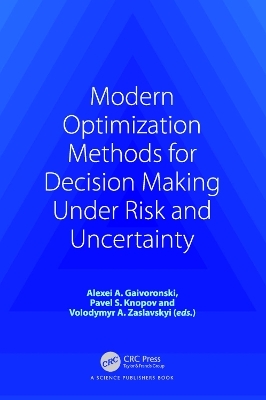
Modern Optimization Methods for Decision Making Under Risk and Uncertainty
CRC Press (Verlag)
978-1-032-19641-1 (ISBN)
The book comprises original articles on topical issues of risk theory, rational decision making, statistical decisions, and control of stochastic systems. The articles are the outcome of a series international projects involving the leading scholars in the field of modern stochastic optimization and decision making. The structure of stochastic optimization solvers is described. The solvers in general implement stochastic quasi-gradient methods for optimization and identification of complex nonlinear models. These models constitute an important methodology for finding optimal decisions under risk and uncertainty. While a large part of current approaches towards optimization under uncertainty stems from linear programming (LP) and often results in large LPs of special structure, stochastic quasi-gradient methods confront nonlinearities directly without need of linearization. This makes them an appropriate tool for solving complex nonlinear problems, concurrent optimization and simulation models, and equilibrium situations of different types, for instance, Nash or Stackelberg equilibrium situations. The solver finds the equilibrium solution when the optimization model describes the system with several actors. The solver is parallelizable, performing several simulation threads in parallel. It is capable of solving stochastic optimization problems, finding stochastic Nash equilibria, and of composite stochastic bilevel problems where each level may require the solution of stochastic optimization problem or finding Nash equilibrium. Several complex examples with applications to water resources management, energy markets, pricing of services on social networks are provided. In the case of power system, regulator makes decision on the final expansion plan, considering the strategic behavior of regulated companies and coordinating the interests of different economic entities. Such a plan can be an equilibrium − a planned decision where a company cannot increase its expected gain unilaterally.
Alexei A. Gaivoronski obtained Master and PhD degrees in operations research from Moscow University of Physics and Technology (1977 and 1980). His research interests are optimization under uncertainty, risk management, information economics with applications to finance, energy, telecommunications where he published more than 80 research papers. He is Professor of industrial economics and operations research in Norwegian University of Science and Technology. Previously he worked in academia and industry in Ukraine, Austria, France and Italy. Pavel S. Knopov is the Head of Department, Mathematical Methods of Operation Research at the V.M. Glushkov Institute of Cybernetics National Academy of Science of Ukraine and Professor of National Taras Shevchenko University, Kiev, Ukraine. His research interest are stochastic optimization problems, problems of estimation of random processes and fields, control of random processes and field(s), Risk theory. He has supervised Master and PhD students and been a leader of several international projects. Volodymyr A. Zaslavskyi is a Doctor of Sciences (Technologies), Professor of Department of Mathematical Informatics, Faculty of Computer Science and Cybernetics, Taras Shevchenko National University of Kyiv. His research interest includes risk analyses and optimization, systems analyses and type-variety principle applications, optimal redundancy and life cycle of critical systems. Guarantee of MAP "Business Informatics", He has supervisor of Master and PhD students, and been Leader of several international projects.
Preface. Optimization of Complex Simulation Models with Stochastic Gradient Methods. Linking Catastrophe Modeling and Stochastic Optimization techniques for Integrated Catastrophe Risk Analysis and Management. Authentication for Coalition Groups. Robust Constructions of Risk Measures for Optimization under Uncertainty. On Minimum Length Confidence Intervals. The independence number of the generalized wheel graphs Wp2k+1. Approximations for Estimating Some Options Using the Inverse of the Laplace Transform. A Nash Equilibrium based Model of Agents Coordination through Revenue Sharing and Applications to Telecommunications. Nash Equilibrium and its Modern Applications. On the Vector Optimal Control of Risk Processes. The Type-Variety Principle in Ensuring the Reliability, Safety and Resilience of Critical Infrastructures. Informational Extended Games and Decision-Making Processes at Risk and Uncertainty. Energy Production and Storage Investments and Operation Planning Involving Variable Renewable Energy Sources: A Two-Stage Stochastic Optimization Model with Rolling Time Horizon and Random Stopping Time. How the Market Power of Electricity Suppliers and a Carbon Price Together Affect the Restructured Electricity Markets. Safety of Water Resources of River Basin. Optimization problems for retrial queues with unreliable server.
| Erscheinungsdatum | 10.10.2023 |
|---|---|
| Zusatzinfo | 21 Tables, black and white; 16 Illustrations, color; 23 Illustrations, black and white |
| Verlagsort | London |
| Sprache | englisch |
| Maße | 156 x 234 mm |
| Gewicht | 875 g |
| Themenwelt | Mathematik / Informatik ► Informatik ► Theorie / Studium |
| Technik ► Elektrotechnik / Energietechnik | |
| Technik ► Umwelttechnik / Biotechnologie | |
| ISBN-10 | 1-032-19641-6 / 1032196416 |
| ISBN-13 | 978-1-032-19641-1 / 9781032196411 |
| Zustand | Neuware |
| Haben Sie eine Frage zum Produkt? |
aus dem Bereich


